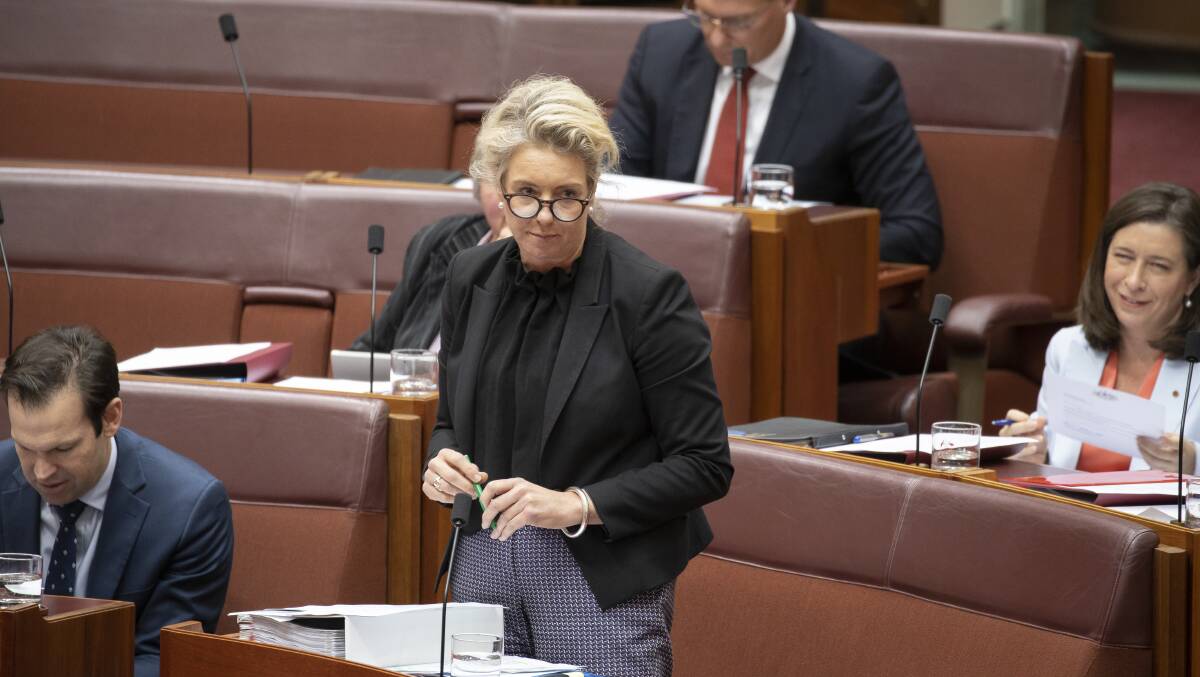
Embattled Deputy Nationals leader Bridget McKenzie has been embroiled in another government grants controversy, this time involving grants designed to assist drought-affected towns.
The Drought Communities Program Extension gives councils in eligible areas up to $1 million for drought relief projects.
Prime Minister Scott Morrison announced an extra 52 councils would be eligible for the program, during a visit to Orange and Blayney on Tuesday.
But councils that did not meet the eligibility criteria were given grants during the 2019 election campaign.
Senator McKenzie - who is under investigation over her handling of the $100 million Community Sport Infrastructure Grant program - was responsible for the program in the lead-up to the election, as the Minister for Regional Services, Sport, Local Government and Decentralisation.
Councils were deemed to be eligible if they had below average rainfall in 12 of the 24 months leading up to the cut-off date. It also required 17 per cent of employment in the local government area to be linked to agriculture, forestry or fishing.
Fourteen councils were announced as eligible during the 2019 election campaign - after caretaker period had commenced.
But six of the 14 areas didn't meet the 17 per cent employment threshold.
Eight of the 14 areas also had a rainfall deficiency of less than 50 per cent.
Thirteen of the councils that got funding are in seats that were ultimately held by the coalition.
They include Balranald, Berrigan, Hay and Federation local government areas. Liberal MP Sussan Ley is the local member.
All four local government areas had a rainfall deficiency of less than 50 per cent, an answer to a question on notice from November 8 shows.
In the Federation council area, there was a rainfall deficiency of just 13.3 per cent.
Hay's rainfall deficiency was 37.3 per cent; Balranald's was 39.4 per cent; and Berrigan was 43.5 per cent.
South Australian Liberal MP Rowen Ramsay is the federal member for Adelaide Plains, Copper Coast, Port Pirie City and District and Unincorporated Far North councils, which also got funding under the program.
While only Unincorporated Far North councils did not meet the rainfall criteria, with a deficiency of 44.2 per cent, the other three failed to meet the employment criteria by a long way.
Only 10.15 per cent of industry in Adelaide Plains was linked to agriculture; 9.05 per cent in Alexandrina; 7.96 per cent in Copper Coast and 4.24 per cent in Port Pirie City and District.
The only non-Coalition seat to get funding was Alexandrina in South Australia. It is in the electroate of Mayo, which was held by Rebekha Sharkie. While the area had a rainfall deficiency of 92.9 per cent, it only had employment in agriculture, forestry and fisheries of 9.05 per cent.
A spokeswoman for Senator McKenzie said the minister "rejected the characterisation of the program, which delivered much needed funding to drought-affected areas".
"The aim of the program was to get support to where it was needed," the spokeswoman said.
The revelations come as Prime Minister and Cabinet secretary Phil Gaetjens continues to investigate whether Senator McKenzie breached ministerial standards through her misuse of the grants program.
She has been under sustained pressure to resign since the audit - which was sparked by Liberal candidate Georgina Downer's oversized cheque to a South Australian bowling club - dropped two weeks ago. However she has defended her actions, as all grant recipients were technically eligible.
Meanwhile, Drought Minister David Littleproud has denied there was pork barrelling afoot in this latest round of drought grants.
All but five of the councils that were announced for funding on Tuesday are in areas held by the Coalition.
"The fact that they're in Coalition seats just is a matter of where the election results fell," Mr Littleproud said.
Agriculture Minister Senator McKenzie was also missing while the funding was announced.
Mr Morrison denied there was anything untoward about her absence.
"Today we've made two announcements. One on the Drought Community Program, which is administrated by Minister Littleproud, and the other which is a 10-year announcement administrated by the Minister for Education," Mr Morrison said.
But Labor said the Coalition had to "come clean" on how it was distributing drought funding.
"Australians are fed up with the secrecy and political games from the Morrison Government on the drought," Labor's spokeswoman for infrastructure, transport and regional development Catherine King said.
"The latest announcement comes with no transparency on why the 52 councils were included, and leaves many others clueless why they continue to miss out."
The drought relief program originally came under fire after $1 million was announced for the Moyne Shire in Victoria when it had "grey skies, wet grass and plenty of feed".
The Coalition government had insisted the area did qualify, due to a Bureau of Meteorology map which showed 60 per cent of the shire was in drought.
The government later admitted the Infrastructure Department had used the wrong weather data, which triggered a review of the whole process.
But The Canberra Times later learnt the Infrastructure Department was relying on criteria that categorised areas in drought after only a few dry months.
The process was described as "problematic" by a senior member of the Bureau of Meteorology.
Mr Littleproud confirmed on Tuesday the criteria for the drought program had changed following an Ernst and Young review of the scheme.
Now the workforce criteria is 12 per cent. It also takes into account industries that are connected to agriculture, such as abattoir workers or mechanics.
But Mr Littleproud was forced to defend the scheme, after it was revealed councils like Yass and Orange are still ineligible for assistance.
"This is Australian taxpayers' money. We've gotta be careful with it and it's gotta go to those in most need," Mr Littleproud said.
This article first appeared on the Canberra Times.


